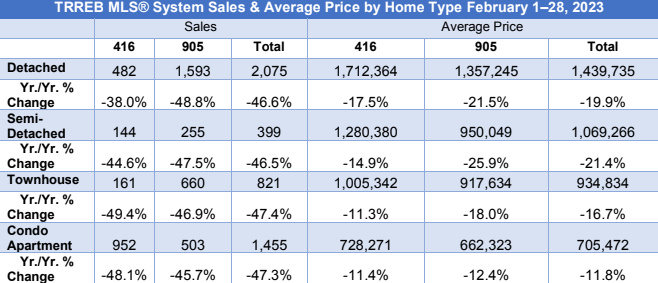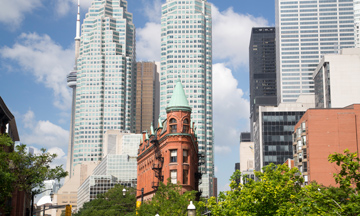
Signs of renewed activity are apparent throughout the GTA. Last year we saw downward pricing pressure due to lingering consumer uncertainty and higher borrowing costs. In February the Toronto Regional Real Estate Board (TTREB) reported 4,783 properties sold in the Greater Toronto Area (GTA). Historically it has been years since a February market has produced such low numbers however from a more recent perspective these numbers are encouraging. This is the first month-over-month gain since August and an almost 55% increase from January’s sales volume.
It is almost pointless to compare February 2023 with February 2022. February 2022 was when residential real estate sales reached the height of the frenzied pandemic market. The average sale price in the GTA last February was $1,334,544. This is the highest average sale price on record and will remain so for some time. In March of last year, the Bank of Canada initiated its continuous implementation of higher rates from .25% to the current 4.5%. The real estate market quickly began a downward spiral with the higher rates, but this continuous decline over almost the past year appears to be over – and supported by February’s data along with the continued momentum into the first part of March.

The average selling price in the GTA for all homes sold was $1,095,617 in February. While the comparison from this time last year may seem shocking, the data is promising when compared on a month-over-month basis. On a monthly basis, prices were up across the GTA with the average price growing 5.5% compared to January’s $1,038,668. Although all housing types in both Toronto and the 905 region saw month-over-month gains, it was Toronto’s detached and semi-detached homes that championed, with prices rising 15.2% and 11.3%, respectively.

It is also interesting to note a shift in the number of lower-priced homes that are being purchased. In February, more than half — 57% — of the GTA’s home sales were below $1M, a noticeable change from the 38% they accounted for one year prior.
“Many homebuyers have also decided to purchase a lower-priced home to help offset higher borrowing costs. The share of home purchases below one million dollars is up substantially compared to this time last year,” said Toronto Regional Real Estate Board (TRREB) President Paul Baron.
Across the Greater Toronto Area, homes in Richmond Hill, Markham and Toronto have fared the best over the past year in the home price index, falling 12 per cent, 13 per cent and 14 per cent, respectively.
Buyer activity has really picked up in recent weeks, but the number of listings isn’t keeping up. In February only 8,367 new listings came on the market — a 40.9% decline over the 14,153 that came to market last February. In the last couple of weeks, showings have increased dramatically and there are a lot of multiple offer situations taking place. As TRREB Chief Market Analyst Jason Mercer explains, this could be good news for sellers who do decide to list in the near future.
“This increased demand will run up against a constrained supply of listings and lead to increased competition between buyers,” Mercer said. “This will eventually lead to renewed price growth in many segments of the market, especially those catering to first-time buyers facing increased rental costs.”
Moving into the spring given the market is improving, the market should see more supply which is typical for this time of year. It will by no means address the supply-side issues the region is facing, however with some more selection available and no anticipated rate hikes in the short term we should see an increase in sales volume. Buyers who may have been hesitant to transact in the latter half of 2022 seem to be returning to the market.
Low inventory levels are far from being a new problem for the GTA, but with affordability strained and such few options on the market, TRREB CEO John DiMichele says the need to create more housing supply is as important as ever.
“As we move toward a June mayoral by-election in Toronto, housing supply will once again be front and centre in the policy debate,” DiMichele said. “New and innovative solutions, including the City of Toronto’s initiative to allow duplexes, triplexes and fourplexes in all neighbourhoods citywide, need to come to fruition if we are to achieve an adequate and diverse housing supply that will support record population growth in the years to come.”


